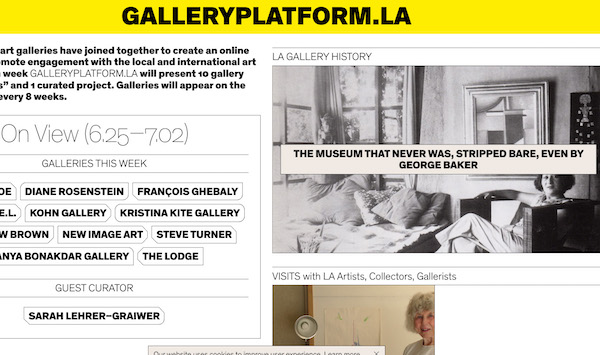If there’s been a silver lining for the LA art scene during the pandemic, it just might be the new Gallery Association Los Angeles (GALA) an online platform known as GalleryPlatform.LA, that has taken root while everyone was quarantining. Brainchild of uber-gallerist and former MoCA LA Director Jeffrey Deitch, the platform got off the ground with no fewer than 81 local galleries.
Most gallerists feel that a gallery association is something long overdue and that a centralized website with a changing lineup of 10 galleries per week is a great idea. The site was quickly built out in April, with voluntary contributions from individual galleries and with sponsorship funds from East West Bank that will underwrite the curatorial portion of the site consisting of videos of artist and gallery visits.
The organic nature of the platform was emphasized by the gallerists I talked with. Members of the organizational committee volunteered to serve. They spoke of the collegial approach to the operation of the association and the site that operates without a leader. With big galleries and smaller cutting-edge galleries sharing the space, there is a “leveling of the playing field.”
Potential buyers of artwork displayed on the site can connect with each individual gallery. The terms and conditions of the sale are discussed by the gallery directly with the buyer and the platform itself does not take a fee on the sales. While most galleries display prices on the site, there is no requirement to do so.

The conventional wisdom is that buyers need to view artwork in person before writing a check. However, that habit may be fading with the advent of online platforms. Some are established (such as Artsy and Artnet) while others are new, such as Sotheby’s Network—for galleries that want to sell on the auction house’s platform with Sotheby’s taking a commission.
Ben Lee Ritchie Handler of Nicodim Gallery in DTLA, who is on the operating committee, said that Deitch reached out in mid-March asking Nicodim to join. Handler was excited about the gallery association and hoped that the association would “create an off-line community as soon as we can see each other in-person again.” He was eager to avoid the Saturday night massacre in which dozens of galleries open for the same two hours, frustrating art patrons—a problem the association may address.
Sara Hantman, senior director of Various Small Fires on Highland Avenue, is also a member of the operating committee—nominated by Handler. VSF was among the 10 galleries in the platform’s first rotation. It had immediate success with veteran Southern California artist Jessie Homer French, whose folk-art style is reminiscent of Grandma Moses. This show was unable to be open to the public, but sold out on the platform.
French’s recent work focuses on the forbidden zone around the 1986 Chernobyl nuclear disaster in Ukraine—which has gone “native,” with forests regenerating and wildlife occupying areas around buildings devoid of humans. She paints flora and fauna that have thrived in the zone, including wolf packs. The work has resonance during the pandemic, when coyotes boldly saunter down empty streets in major cities.

Jessie Homer French, “Genesis,” 2017
Hantman supports price transparency on the platform and prices were posted for French’s work. She calls it “a lease free space,” and is pleased with the mix of galleries with “the large galleries attracting bigger collectors and the smaller galleries having interesting art for them to buy.”
Gan Uyeda, director of François Ghebaly Gallery in DTLA, is a member of the editorial committee that oversees gallery and artists profiles on the site. He said that the platform helps support the smaller galleries and it’s in the larger galleries’ interest to join with them since “if the bottom drops out of the art world, then the whole ecosystem could collapse.”
Adam Moscowitz of Moscowitz Bayse Gallery on La Brea Avenue, said that while David Zwirner Gallery was “a pioneer” with his hosted website, “It’s about David Zwirner presents.” He prefers the independence of GalleryPlatform.LA. His partner, Meredith Bayse, saw it as “an opportunity to think of the online experience as distinct from exhibitions at the gallery.”
Diane Rosenstein, owner of her eponymous gallery on Highland Avenue, said Deitch emailed her and other galleries in mid-April, and she agreed to join the platform. On the issue of price transparency, she said she will post prices (a growing trend with online sites)—even the notoriously opaque Gagosian Gallery posted prices of Ed Ruscha’s recent work on the platform. Rosenstein said the platform is here to stay: “It’s not just a stop-gap, but a complement to everything else we’re doing.”

